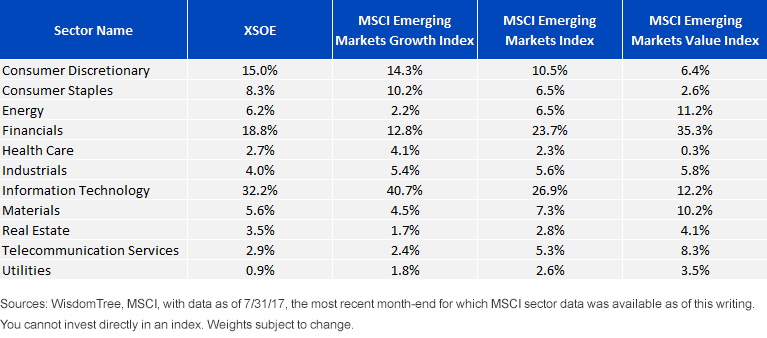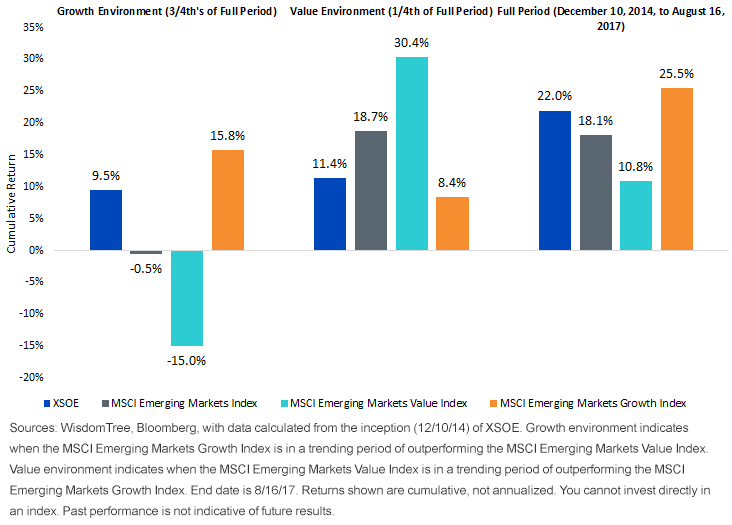In Emerging Markets—Value, Growth or Ex-State Owned?


More Sophisticated Emerging Market Equity Allocations
Five or 10 years ago, the majority of exchange-traded fund (ETF) emerging market investors were focused on the same exact benchmark—the MSCI Emerging Markets Index. This Index is currently exposed to 23 markets and a variety of sectors. It has gone from a very heavy commodity focus about a decade ago running into the oil run-up (think summer of 20081) to now being very tech focused.2 But as equity investors look for “smart beta” factors, we encourage you to take a look at a specific risk factor: government involvement in companies, what we refer to as state ownership risk.
“I Don’t Want to Invest Alongside Emerging Market Governments”
On August 18, 2014, WisdomTree began live calculation of its Emerging Markets ex-State-Owned Enterprises Index, tracked by the WisdomTree Emerging Markets ex-State-Owned Enterprises Fund (XSOE).
The Goal: To have similar country exposures as a market capitalization-weighted universe3 of emerging market equities, while eliminating exposure to those firms with greater than 20% ownership from a government entity, which made up approximately 30% of the MSCI Emerging Markets Index back in August 2014, representing five of the 10 top individual companies.4
If one thinks instead of the WisdomTree Emerging Markets Dividend Index—a way to look solely at dividend payers in emerging markets weighted by the dividends that they pay—eight of the top 10 individual companies in August 2014 would have been state-owned by our methodology.5
With the introduction of XSOE, investors gained a choice to no longer have to naively invest alongside emerging market governments, thereby managing an important risk from a U.S. investor’s perspective. In many ways, this is focusing on the “G in ESG”—environmental, social and governance investing—with the focus, of course, being on the governance more aligned with shareholders and not with a state actor.
Value, Growth or ex-State Owned?
As is always the case when introducing something completely new, a critical question regards how it fits in the current landscape. The value/growth distinction is very well known, whereas what it means to be “ex-state owned” is not. We examine the sector picture to note any similarities.
XSOE Seems to Fall Somewhere between “Growth” and “Core” on Sector Basis

- XSOE Exhibited Some Similarities to Growth: Certain sector positioning looked quite similar to that of the MSCI Emerging Markets Growth Index, such as Consumer Discretionary, Consumer Staples, Telecommunication Services and Utilities. Information Technology is also notable—not quite at the 40.7% seen in the MSCI Emerging Markets Growth Index, but still at a significant over-weight compared to the MSCI Emerging Markets Index. WisdomTree constrains the sector weights in a band around its starting universe market cap,6 while the MSCI Emerging Markets Growth Index does not—hence why the tilts are more extreme there.
- XSOE Exhibited Some Similarities to Core: Certain sector positioning looked quite similar to that of the MSCI Emerging Markets Index, such as Energy, Health Care and Real Estate.
- Quite Difficult to Compare XSOE to Value: What’s clear is that the MSCI Emerging Markets Value Index tilted exposure away from Consumer Discretionary, Consumer Staples and Information Technology, but toward Energy, Financials, Materials, Telecommunication Services and Utilities. Our research indicates that the classic “value” approaches to emerging markets tend to tilt TOWARD state-owned companies.
When “Value” Has Led, Has “ex-State Owned” Held Up?
This is the critical question, since we also know that styles like value and growth tend to come in and out of favor. Can the approach employed to avoid state-owned companies mitigate some of these ups and downs?
Was This a “Good” Period for Growth or a “Bad” Period for Value?

- It’s important to take a step back, first considering what accounted for the rather large difference in overall cumulative returns for the growth and value environments. Notably, the growth environment saw the price of oil decline by nearly 65% on a cumulative basis. In emerging markets, one of the primary characterizations of a “value” exposure has tended to be a large weight to Energy, and it’s notable that many of the largest oil-focused Energy firms are in fact state-owned. Therefore, what we’re really noting here is that in a tough emerging market environment, tilting in the “growth” direction also steered away from one of the hardest-hit areas of the market at that time.
- Similarly, the value environment encapsulated those times when the oil price was rallying back. Also notable (and related to the price behavior of oil) is that, during the growth environment, the U.S. dollar was trending toward strength, and during the value environment, the U.S. dollar was trending toward weakness. Big picture: A weaker dollar has tended to be another boon to those investors focused on emerging markets.
Growth May Be More Defensive in Market Downdrafts Driven by the Energy Sector
Intuition tells us that value strategies have historically delivered outperformance during tougher market environments, but since “value” in emerging markets has become entwined with Energy, depending on the nature of a given correction, growth may actually tend toward more defensive characteristics. XSOE, by tracking the WisdomTree Emerging Markets ex-State-Owned Enterprises Index, has naturally tilted away from this sector, leading to a fairly interesting early track record of performance.
1Source: Bloomberg; refers to the price per barrel of Brent Crude oil, which closed at $146.08 on 7/3/08.
2Source: Bloomberg; refers to weight of Information Technology firms, 26.87%, in the MSCI Emerging Markets Index as of 8/16/17. This was the largest sector weight.
3Refers to WisdomTree’s total universe of emerging market companies prior to removing the state-owned enterprises.
4Sources: WisdomTree, Bloomberg, with data as of 8/29/14, the closest month-end after the start of live calculation for the WisdomTree Emerging Markets ex-State-Owned Enterprises Index.
5Sources: WisdomTree, Bloomberg, with data as of 8/29/14.
6After country weights are adjusted, should any sector of the WisdomTree Emerging Markets ex-State-Owned Enterprises Index have a weight that is more than 3% higher or lower than the starting universe, its weight will be adjusted such that it becomes 3% higher or lower than its original starting universe weight.
Important Risks Related to this Article
There are risks associated with investing, including possible loss of principal. Foreign investing involves special risks, such as risk of loss from currency fluctuation or political or economic uncertainty. Investments in emerging or offshore markets are generally less liquid and less efficient than investments in developed markets and are subject to additional risks, such as risks of adverse governmental regulation and intervention or political developments. Funds focusing their investments on certain sectors and/or regions increase their vulnerability to any single economic or regulatory development. This may result in greater share price volatility. Investments in currency involve additional special risks, such as credit risk and interest rate fluctuations. The Fund invests in the securities included in, or representative of, its Index regardless of their investment merit and the Fund does not attempt to outperform its Index or take defensive positions in declining markets. Please read the Fund’s prospectus for specific details regarding the Fund’s risk profile.
Investments focusing on certain sectors and/or smaller companies increase their vulnerability to any single economic or regulatory development. This may result in greater share price volatility.

Christopher Gannatti began at WisdomTree as a Research Analyst in December 2010, working directly with Jeremy Schwartz, CFA®, Director of Research. In January of 2014, he was promoted to Associate Director of Research where he was responsible to lead different groups of analysts and strategists within the broader Research team at WisdomTree. In February of 2018, Christopher was promoted to Head of Research, Europe, where he was based out of WisdomTree’s London office and was responsible for the full WisdomTree research effort within the European market, as well as supporting the UCITs platform globally. In November 2021, Christopher was promoted to Global Head of Research, now responsible for numerous communications on investment strategy globally, particularly in the thematic equity space. Christopher came to WisdomTree from Lord Abbett, where he worked for four and a half years as a Regional Consultant. He received his MBA in Quantitative Finance, Accounting, and Economics from NYU’s Stern School of Business in 2010, and he received his bachelor’s degree from Colgate University in Economics in 2006. Christopher is a holder of the Chartered Financial Analyst Designation.

